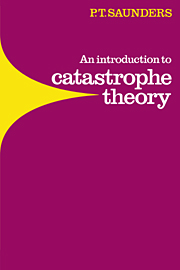Book contents
- Frontmatter
- Contents
- Preface
- 1 Introduction
- 2 Background
- 3 The seven elementary catastrophes
- 4 The geometry of the seven elementary catastrophes
- 5 Applications in physics
- 6 Applications in the social sciences
- 7 Applications in biology
- 8 Morphogenesis
- 9 Conclusions
- Exercises
- Appendix. Elementary catastrophes of codimension ≦ 5
- References
- Author index
- Subject index
- Frontmatter
- Contents
- Preface
- 1 Introduction
- 2 Background
- 3 The seven elementary catastrophes
- 4 The geometry of the seven elementary catastrophes
- 5 Applications in physics
- 6 Applications in the social sciences
- 7 Applications in biology
- 8 Morphogenesis
- 9 Conclusions
- Exercises
- Appendix. Elementary catastrophes of codimension ≦ 5
- References
- Author index
- Subject index
Summary
In this chapter we bring together the different ways in which we have seen that catastrophe theory can be applied, and we discuss how catastrophe theory compares with other methods as a means of explaining nature.
Applications of catastrophe theory
We began our study of the applications of catastrophe theory by quoting Thorn's observation that they form a spectrum of different types. Now that we have seen a number of applications we can describe the spectrum in more detail.
At the extreme ‘physical’ end, catastrophe theory is used much like any other mathematical method, to help us discover the properties of a known, or at any rate postulated, dynamic. For example, when we are studying the buckling of elastic structures or the stability of ships (Zeeman, 1977a), the concept of a universal unfolding and the techniques for finding one can warn us when our analysis is structurally unstable and can be used to suggest what further effects are to be expected. Catastrophe theory can also be used to establish results which are true for a large class of systems, each with a known dynamic; Berry's (1976) work on caustics, which we discussed in Chapter 5, is a good example.
In the middle of the spectrum are the applications to the study of systems whose mechanisms are not known in sufficient detail for us to write down and solve the equations that describe them, but for which we are reasonably confident that we know the sorts of equations that are involved.
- Type
- Chapter
- Information
- An Introduction to Catastrophe Theory , pp. 127 - 133Publisher: Cambridge University PressPrint publication year: 1980



